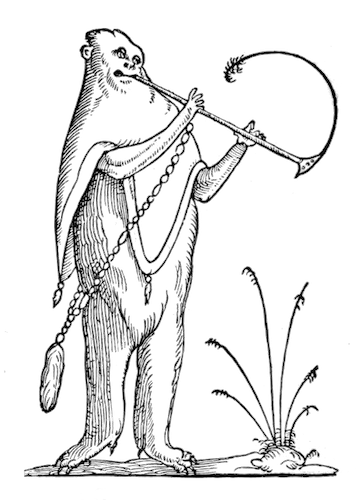
Essays

Cat Pianos, Sound-Houses, and Other Imaginary Musical Instruments
Deirdre Loughridge and Thomas Patteson, curators of the Museum of Imaginary Musical Instruments, explore the wonderful history of made-up musical contraptions, including a piano comprised of yelping cats and Francis Bacon's 17th-century vision of experimental sound manipulation. more

The author of Alice's Adventures in Wonderland, which sees its 150th anniversary this year, remains to this day an enigmatic figure. Jenny Woolf explores the joys and struggles of this brilliant, secretive, and complex man, creator of one of the world's best-loved stories. more

A Bestiary of Sir Thomas Browne
Hugh Aldersey-Williams takes a tour through Thomas Browne's Pseudodoxia Epidemica, a work which sees one of the 17th-century's greatest writers stylishly debunk all manner of myths, in particular those relating to the world of animals. more

The Nightwalker and the Nocturnal Picaresque
The introduction of street lighting to 17th-century London saw an explosion of nocturnal activity in the capital, most of it centring around the selling of sex. Matthew Beaumont explores how some writers, with the intention of condemning these nefarious goings-on, took to the city's streets after dark, and in the process gave birth to a peculiar new literary genre. more

The Empathetic Camera: Frank Norris and the Invention of Film Editing
At the heart of American author Frank Norris' gritty turn-of-the-century fiction lies an essential engagement with the everyday shock and violence of modernity. Henry Giardina explores how this focus, combined with his unique approach to storytelling, helped to pave the way for a truly filmic style. more

Scurvy and the Terra Incognita
One remarkable symptom of scurvy, that constant bane of the Age of Discovery, was the acute and morbid heightening of the senses. Jonathan Lamb explores how this unusual effect of sailing into uncharted territory echoed a different kind of voyage, one undertaken by the Empiricists through their experiments in enhancing the senses artificially. more

Forgotten Failures of African Exploration
Dane Kennedy reflects on two disastrous expeditions into Africa organised by the British in the early-19th century, and how their lofty ambitions crumbled before the implacable realities of the continent. more

Should we consider black a colour, the absence of colour, or a suspension of vision produced by a deprivation of light? Beginning with Robert Fludd's attempt to picture nothingness, Eugene Thacker reflects* on some of the ways in which blackness has been used and thought about through the history of art and philosophical thought. more

Ignorant Armies: Private Snafu Goes to War
Between 1943 and 1945, with the help of Warner Bros.' finest, the U.S. Army produced a series of 27 propaganda cartoons depicting the calamitous adventures of Private Snafu. Mark David Kaufman explores their overarching theme of containment and how one film inadvertently let slip one of the war's greatest secrets. more

Sex and Science in Robert Thornton’s Temple of Flora
Bridal beds, blushing captives, and swollen trunks - Carl Linnaeus' taxonomy of plants heralded a whole new era in 18th-century Europe of plants being spoken of in sexualised terms. Martin Kemp explores* how this association between the floral and erotic reached its visual zenith in Robert Thornton's exquisitely illustrated Temple of Flora. more

The Eternal Guffaw: John Leech and The Comic History of Rome
At the beginning of the 1850s, two stalwarts from the heart of London-based satirical magazine Punch, Gilbert Abbott à Beckett and John Leech, cast their mocking eye a little further back in time and published The Comic History of Rome. Caroline Wazer explores how it is not in the text but rather in Leech's delightfully anachronistic illustrations that the book's true subversion lies, offering as they do a critique of Victorian society itself. more

Neanderthals in 3D: L’Homme de La Chapelle
More than just a favourite of Victorian home entertainment, the stereoscope and the 3D images it created were also used in the field of science. Lydia Pyne explores how the French palaeontologist Marcellin Boule utilised the device in his groundbreaking monograph analysing one of the early-20th-century's most significant archaeological discoveries - the Neanderthal skeleton of La Chapelle. more

When Chocolate was Medicine: Colmenero, Wadsworth, and Dufour
Chocolate has not always been the common confectionary we experience today. When it first arrived from the Americas into Europe in the 17th century it was a rare and mysterious substance, thought more of as a drug than as a food. Christine Jones traces the history and literature of its reception. more

Julia Pastrana: A “Monster to the Whole World”
Julia Pastrana, a woman from Mexico born with hypertrichosis, became one of the most famous human curiosities of the 19th century, exhibited the world over as a "bearded lady" while both alive and dead. Bess Lovejoy explores her story and how it was only in 2013, 153 years after her passing, that she was finally laid to rest. more

Illustrations of Madness: James Tilly Matthews and the Air Loom
Mike Jay recounts the tragic story of James Tilly Matthews, a former peace activist of the Napoleonic Wars who was confined to London's notorious Bedlam asylum in 1797 for believing that his mind was under the control of the “Air Loom” — a terrifying machine whose mesmeric rays and mysterious gases were brainwashing politicians and plunging Europe into revolution, terror, and war. more

Wild Heart Turning White: Georg Trakl and Cocaine
To mark the 100th anniversary of the death by cocaine overdose of Austrian lyric poet Georg Trakl, Richard Millington explores the role the drug played in Trakl's life and works. more

The Poet, the Physician and the Birth of the Modern Vampire
From that famed night of ghost-stories in a Lake Geneva villa in 1816, as well as Frankenstein's monster, there arose that other great figure of 19th-century gothic fiction - the vampire - a creation of Lord Byron's personal physician John Polidori. Andrew McConnell Stott explores how a fractious relationship between Polidori and his poet employer lies behind the tale, with Byron himself providing a model for the blood-sucking aristocratic figure of the legend we are familiar with today. more

Ben Merriman presents a selection of piracy cases from the proceedings of London's Old Bailey. Although a few live up to the swashbuckling heists of stereotype, many reveal the surprisingly everyday nature of the maritime crimes brought before the court, including cases involving an argument over chickens and the stealing of a captain's hats. more

Ghostwriter and Ghost: The Strange Case of Pearl Curran & Patience Worth
In early 20th-century St. Louis, Pearl Curran claimed to have conjured a long-dead New England puritan named Patience Worth through a Ouija board. Although mostly unknown today, the resulting books, poems, and plays that Worth "dictated" to Curran earned great praise at the time. Ed Simon investigates the curious and nearly forgotten literary fruits of a “ghost” and her ghostwriter. more

Redressing the Balance: Levinus Vincent’s Wonder Theatre of Nature
Bert van de Roemer explores the curiosity cabinet of the Dutch collector Levinus Vincent and how the aesthetic drive behind his meticulous ordering of the contents was in essence religious, an attempt to emphasise the wonder of God's creations by restoring the natural world to its prelapsarian harmony. more

“O, Excellent Air Bag”: Humphry Davy and Nitrous Oxide
The summer of 1799 saw a new fad take hold in one remarkable circle of British society: the inhalation of "Laughing Gas". The overseer and pioneer of these experiments was a young Humphry Davy, future President of the Royal Society. Mike Jay explores how Davy's extreme and near-fatal regime of self-experimentation with the gas not only marked a new era in the history of science but a turn toward the philosophical and literary romanticism of the century to come. more

This year, the works of one of the most successful and universal writers of all time came into the public domain in many countries around the world. The Tale of Peter Rabbit, The Tale of Squirrel Nutkin, The Tale of Benjamin Bunny, The Tale of Jemima Puddle-Duck - in all, thirty-three books bearing the name “Beatrix Potter” have sold close to 200 million copies. Frank Delaney enquires into the more complex woman behind the safe and warm-hearted stories. more

Julia Margaret Cameron in Ceylon: Idylls of Freshwater vs. Idylls of Rathoongodde
Leaving her close-knit artistic community on the Isle of Wight at the age of sixty to join her husband on the coffee plantations of Ceylon was not an easy move for the celebrated British photographer Julia Margaret Cameron. Eugenia Herbert explores the story behind the move and how the new environment was to impact Cameron's art. more

Simon Werrett explores how artists through the ages have responded to the challenge of representing firework displays, from the highly politicised and allegorical renderings of the early modern period to Whistler's impressionistic Nocturne in Black and Gold. more

